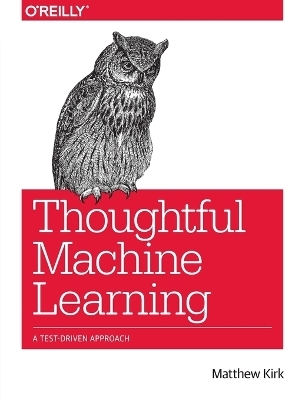
Thoughtful Machine Learning
O'Reilly Media (Verlag)
978-1-4493-7406-8 (ISBN)
- Lieferbar (Termin unbekannt)
- Versandkostenfrei
- Auch auf Rechnung
- Artikel merken
Machine-learning algorithms often have tests baked in, but they can’t account for human errors in coding. Rather than blindly rely on machine-learning results as many researchers have, you can mitigate the risk of errors with TDD and write clean, stable machine-learning code. If you’re familiar with Ruby 2.1, you’re ready to start.
- Apply TDD to write and run tests before you start coding
- Learn the best uses and tradeoffs of eight machine learning algorithms
- Use real-world examples to test each algorithm through engaging, hands-on exercises
- Understand the similarities between TDD and the scientific method for validating solutions
- Be aware of the risks of machine learning, such as underfitting and overfitting data
- Explore techniques for improving your machine-learning models or data extraction
Matthew Kirk holds a B.S. in Economics and a B.S. in Applied and Computational Mathematical Sciences with a concentration in Quantitative Economics from the University of Washington. He started Modulus 7, a data science and Ruby development consulting firm, in early 2012. Matthew has spoken around the world about using machine learning and data science with Ruby.
Chapter 1Test-Driven Machine Learning
History of Test-Driven Development
TDD and the Scientific Method
Risks with Machine Learning
What to Test for to Reduce Risks
Conclusion
Chapter 2A Quick Introduction to Machine Learning
What Is Machine Learning?
What Can Machine Learning Accomplish?
Mathematical Notation Used Throughout the Book
Conclusion
Chapter 3K-Nearest Neighbors Classification
History of K-Nearest Neighbors Classification
House Happiness Based on a Neighborhood
How Do You Pick K?
What Makes a Neighbor “Near”?
Determining Classes
Beard and Glasses Detection Using KNN and OpenCV
Conclusion
Chapter 4Naive Bayesian Classification
Using Bayes’s Theorem to Find Fraudulent Orders
Naive Bayesian Classifier
Spam Filter
Conclusion
Chapter 5Hidden Markov Models
Tracking User Behavior Using State Machines
Evaluation: Forward-Backward Algorithm
The Decoding Problem through the Viterbi Algorithm
The Learning Problem
Part-of-Speech Tagging with the Brown Corpus
Conclusion
Chapter 6Support Vector Machines
Solving the Loyalty Mapping Problem
Derivation of SVM
Nonlinear Data
Using SVM to Determine Sentiment
Conclusion
Chapter 7Neural Networks
History of Neural Networks
What Is an Artificial Neural Network?
Building Neural Networks
Using a Neural Network to Classify a Language
Conclusion
Chapter 8Clustering
User Cohorts
K-Means Clustering
Expectation Maximization (EM) Clustering
The Impossibility Theorem
Categorizing Music
Conclusion
Chapter 9Kernel Ridge Regression
Collaborative Filtering
Linear Regression Applied to Collaborative Filtering
Introducing Regularization, or Ridge Regression
Kernel Ridge Regression
Wrap-Up of Theory
Collaborative Filtering with Beer Styles
Conclusion
Chapter 10Improving Models and Data Extraction
The Problem with the Curse of Dimensionality
Feature Selection
Feature Transformation
Principal Component Analysis (PCA)
Independent Component Analysis (ICA)
Monitoring Machine Learning Algorithms
Mean Squared Error
The Wilds of Production Environments
Conclusion
Chapter 11Putting It All Together
Machine Learning Algorithms Revisited
How to Use This Information for Solving Problems
What’s Next for You?
| Erscheint lt. Verlag | 11.11.2014 |
|---|---|
| Verlagsort | Sebastopol |
| Sprache | englisch |
| Maße | 178 x 233 mm |
| Gewicht | 408 g |
| Einbandart | kartoniert |
| Themenwelt | Informatik ► Theorie / Studium ► Algorithmen |
| Informatik ► Theorie / Studium ► Künstliche Intelligenz / Robotik | |
| Mathematik / Informatik ► Informatik ► Web / Internet | |
| Schlagworte | Künstliche Intelligenz • Maschinelles Lernen • Ruby • TDD - test-driven development |
| ISBN-10 | 1-4493-7406-9 / 1449374069 |
| ISBN-13 | 978-1-4493-7406-8 / 9781449374068 |
| Zustand | Neuware |
| Haben Sie eine Frage zum Produkt? |
aus dem Bereich


